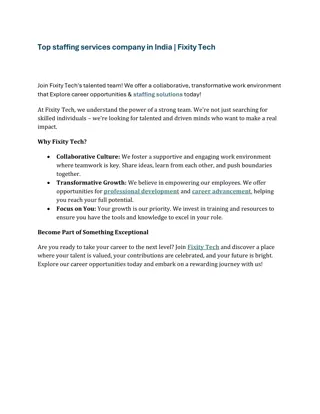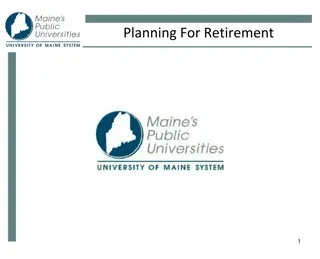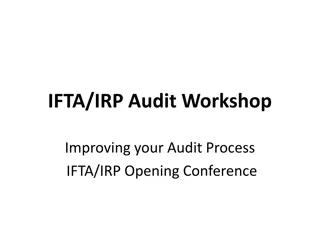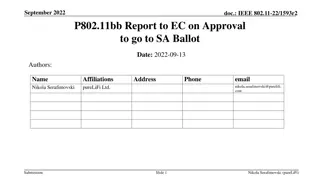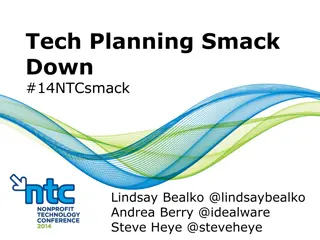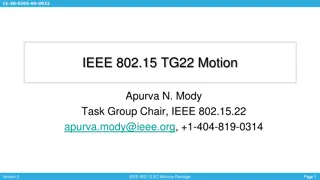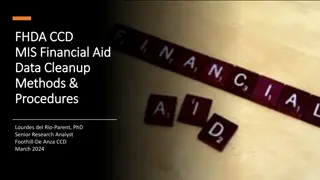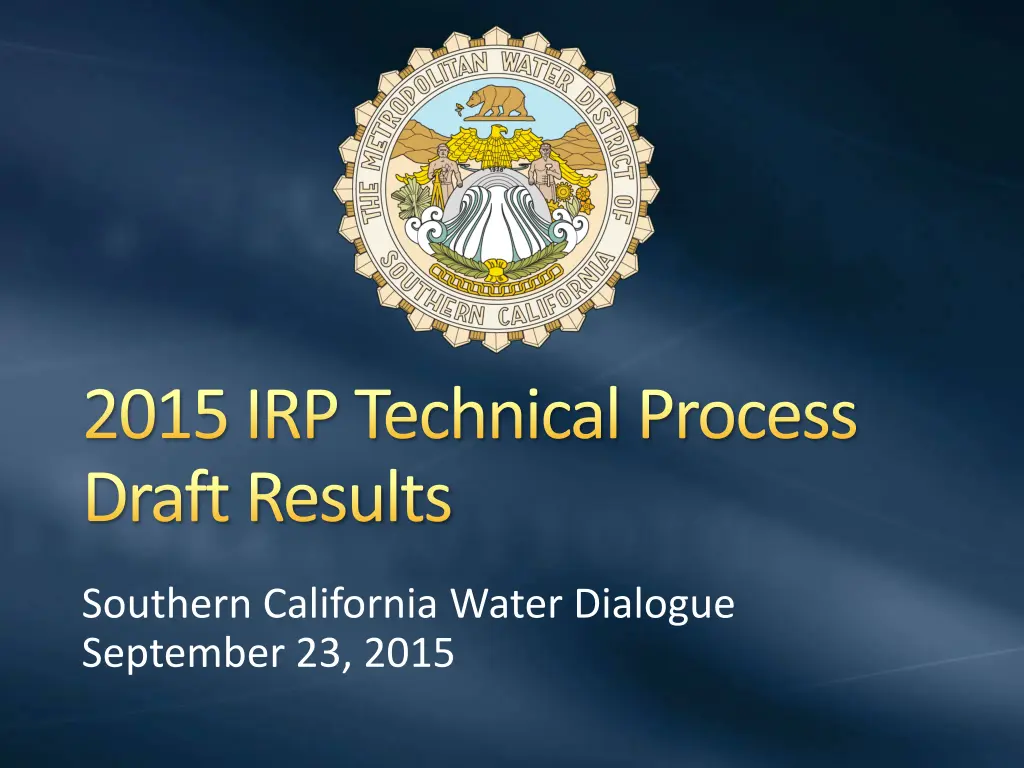
Southern California Water Dialogue IRP Technical Process Update
"Explore the detailed process and schedules of the IRP Technical Updates and Policy Implementations for Southern California's water management. Key questions on supplies, demands, and conservation efforts are addressed with insightful data projections and analysis."
Download Presentation

Please find below an Image/Link to download the presentation.
The content on the website is provided AS IS for your information and personal use only. It may not be sold, licensed, or shared on other websites without obtaining consent from the author. If you encounter any issues during the download, it is possible that the publisher has removed the file from their server.
You are allowed to download the files provided on this website for personal or commercial use, subject to the condition that they are used lawfully. All files are the property of their respective owners.
The content on the website is provided AS IS for your information and personal use only. It may not be sold, licensed, or shared on other websites without obtaining consent from the author.
E N D
Presentation Transcript
2015 IRP Technical Process Draft Results Southern California Water Dialogue September 23, 2015
Phase 1: IRP Technical Update Process and Schedule 2015 Feb Mar Apr May Jun Jul Aug Sep Oct Nov Dec Public Outreach Workshop Board Oral Report Consider Adoption Establish IRP Committee Updates to IRP Committee Member Agency Member Agency Technical Process Technical Draft Report Technical Review and Update Analysis
Phase 2: IRP Policy Implementation Update Process and Schedule 2016 Jan Feb Mar Apr May Jun Board Board Deliberation on Policy and Implementation Published Report Member Agency Member Agency Process Public Public Outreach and Input
Four Key Framing Questions What is our current outlook on supplies and demands? What happens if we do nothing? What happens if we continue developing the current 2010 IRP targets? What potential changes to the current 2010 IRP targets are needed?
What is Our Current Outlook on Supplies and Demands?
Conservation Savings* Projected on 1990 Base Year 800 700 600 Thousand Acre-Feet Conservation Savings* (Thousand Acre-Feet) 500 2020 2025 2030 2035 2040 400 636 667 696 716 746 300 Active Code Based System Loss 200 100 0 2016 2020 2024 2028 2032 2036 2040 Calendar Year *Does not include conservation from Price Effect
Total Retail Demands Key Assumptions Updated demographic forecasts SCAG RTP 12 SANDAG Series 13 Retail M&I Demand New econometric model Agency provided demand forecasts Agricultural Seawater Barrier Replenishment
IRP Draft Forecast Total Retail Demand Historical and Projected 6.0 Pre-Conservation 5.0 Million Acre-Feet 4.0 Post-Conservation 3.0 2.0 Historical Production 1.0 2015 IRP Draft Forecast 0.0 2000 2005 2010 2015 2020 2025 2030 2035 2040 Calendar Year
Near-Term Demand Adjustment Key Assumptions Capture observed reduction in demand Estimate behavioral and structural elements Adjust climate effects and other conservation savings elements to avoid double-counting of reductions in the forecast
Retail Demands Post-Conservation Historical and Projected 6.0 5.0 Million Acre-Feet Range of Total Retail Demands (Million Acre-Feet) 4.0 2020 2025 2030 2035 2040 3.0 Min 3.79 3.86 3.93 3.99 4.03 Avg 4.18 4.26 4.34 4.41 4.46 2.0 Max 4.46 4.56 Draft Adjusted Forecast Range 4.64 4.72 4.78 Historical Production 1.0 2015 IRP Draft Adjusted Forecast 0.0 2000 2005 2010 2015 2020 2025 2030 2035 2040 Calendar Year
Total Average-Year Local Supplies 2015 IRP Draft Forecast 3.0 Seawater Groundwater Recovery Surface Production Desalination 2.5 Million Acre-Feet 2.0 LAA Recycling 1.5 1.0 Groundwater 0.5 0.0 2016 2020 2024 2028 2032 2036 2040 Calendar Year
Total Average-Year Local Supplies 2015 IRP Draft Forecast 3.0 2.5 Million Acre-Feet 2.0 1.5 1.0 0.5 0.0 2016 2020 2024 2028 2032 2036 2040 Calendar Year
Total Range of Local Supplies 2015 IRP Draft Forecast 3.0 2.5 Million Acre-Feet Total Range of Local Supplies (Million Acre-Feet) 2.0 2020 2025 2030 2035 2040 1.5 Min 2.02 2.09 2.11 2.17 2.18 Avg 2.30 2.35 2.38 2.40 2.41 1.0 Max 2.62 2.64 2.67 2.69 2.71 0.5 0.0 2016 2020 2024 2028 2032 2036 2040 Calendar Year
CRA Base Supply Programs 2015 IRP Draft Forecast Lower Colorado 1.2 Southern Nevada WSP Canal Lining MWD PVID Minimum 1.0 Million Acre-Feet Total CRA Base Supplies 0.8 Canal Lining SDCWA (Million Acre-Feet) 2025 IID-MWD 2030 2020 2035 2040 0.6 IID-SDCWA 0.88 0.88 0.92 0.85 0.84 0.4 Basic Apportionment with Adjustments 0.2 0.0 2016 2020 2024 2028 2032 2036 2040 Calendar Year
SWP Existing Conveyance Scenario Draft Forecast Table A + Article 21 2.5 2.0 Million Acre-Feet Total Range of SWP Supplies (Million Acre-Feet) 1.5 2020 2025 2030 2035 2040 Min 0.15 0.15 0.15 0.15 0.15 1.0 Avg 0.84 0.84 0.84 0.84 0.84 Max 1.55 1.55 1.55 1.55 1.55 0.5 0.0 2016 2020 2024 2028 2032 2036 2040 Calendar Year
Metropolitans Storage Programs Central Valley/SWP Storage San Luis Carryover Semitropic Arvin-Edison Kern Delta Mojave DWCV Advance Delivery Lake Mead ICS CRA Storage Local Storage Diamond Valley Lake Mathews Lake Skinner Conjunctive Use Programs DWR State Project Reservoirs
MWD Storage Programs Summary Million Acre-Feet Storage Capacity Put Take 2016 Est. Starting Capacity* Capacity* Central Valley & SWP 1.63 0.54 0.56 0.42 Colorado River 2.39 0.65 0.60 0.22 In-Region 1.30 0.90 0.94 0.14 Total Dry-Year 5.32 2.09 2.10 0.77 Emergency Total 0.63 5.95 0.63 2.72 0 0.63 1.40 2.10 *Shows maximum capacities, actual capacity varies based on contract terms
What Happens if We do Nothing? Do Nothing Case Draft Water Balance
Potential Measures of Reliability Supply shortages Frequency of shortage (a.k.a. probability) Size of shortage IRP reliability goal: 100% reliability under foreseeable hydrologic conditions Storage thresholds Minimum storage level Average storage level
Summary of Shortage Probability Do Nothing Case Draft Water Balance 2020 8% 92% Shortage No Shortage 2025 7% 93% 2030 21% 79% 2035 36% 64% 2040 59% 41% 0% 20% 40% 60% 80% 100%
Summary of Ending Dry-Year Storage Do Nothing Case Draft Water Balance 2020 11% 89% Less Than 1 MAF Greater Than 1 MAF 2025 16% 84% 2030 32% 68% 2035 60% 40% 2040 85% 15% 0% 20% 40% 60% 80% 100%
Observations Do Nothing Case Draft Water Balance The do nothing approach is not sustainable Shortage probability and size both increase over time Total retail demands increase over time Constant or decreasing local and imported supplies Storage quantity decreases over time Less water to store Higher needs for storage to balance supplies and demands Significant resource investments are needed
What Happens if We Develop the 2010 IRP Update Targets? Current IRP Approach Draft Water Balance
Current IRP Development Targets Water Use Efficiency Achieve a 20% reduction in GPCD as a region by 2020 Local Resources Develop ~100 TAF through incentives and partnerships Seek short, mid, and long-term Delta improvements SWP Develop Dry-Year supply programs to fill the aqueduct when needed CRA
Targeted IRP Development Current IRP Approach 800 Delta Improvements Local Augmentation Water Use Efficiency 700 600 Thousand Acre-Feet Targeted Development (Thousand Acre-Feet) 500 2020 2025 2030 2035 2040 400 495 520 545 545 545 300 200 100 0 2020 2025 2030 2035 2040 Calendar Year
Summary of Shortage Probability Do Nothing Case Draft Water Balance 2020 8% 92% Shortage No Shortage 2025 7% 93% 2030 21% 79% 2035 36% 64% 2040 59% 41% 0% 20% 40% 60% 80% 100%
Summary of Shortage Probability Current IRP Approach Draft Water Balance 2020 2% 98% Shortage No Shortage 2025 100% 2030 100% 2035 1% 99% 2040 2% 98% 0% 20% 40% 60% 80% 100%
Summary of Ending Dry-Year Storage Do Nothing Case Draft Water Balance 2020 11% 89% Less Than 1 MAF Greater Than 1 MAF 2025 16% 84% 2030 32% 68% 2035 60% 40% 2040 85% 15% 0% 20% 40% 60% 80% 100%
Summary of Ending Dry-Year Storage Current IRP Approach Draft Water Balance 2020 3% 97% Less Than 1 MAF Greater Than 1 MAF 2025 100% 2030 100% 2035 100% 2040 100% 0% 20% 40% 60% 80% 100%
Observations Current IRP Approach Draft Water Balance Significant resource investments are needed to achieve the current IRP Targets Existing supplies need to maintained Colorado River Aqueduct Local supply production Compared to the Do Nothing Case Reliability measures improve Storage measures improve Challenges still exist in the shorter term
What Potential Changes to the Current IRP Targets are Needed? Adjust targets to address shorter term imbalances Adjust targets to ensure sufficient storage levels Ensure an adequate supply buffer Refine and improve implementation approaches and policy to ensure development
Next Steps Water Tomorrow Phase 1: IRP Technical Update Finalize Results: October 2015 Public Outreach Workshop: October 22nd IRP Committee considers Technical Update adoption: December 2015 IRP Technical Update Final Report: Early 2016 Phase 2: Investigate Policy Implications Kick-off: Early 2016





